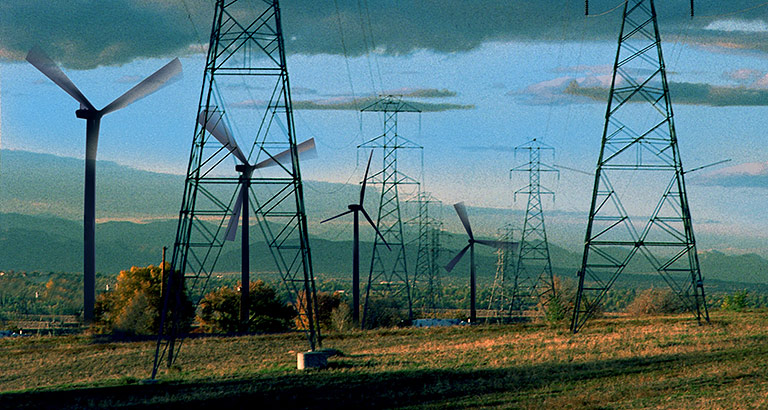NREL's Energy Storage and REopt Teams Awarded $525k from TCF to Study Commercial Viability of Optimal, Reliable Building-Integrated Energy Storage

This sunset view of electrical power towers combined with wind machines are part of the electricity grid that could potentially absorb a large quantity of repurposed EV batteries. Photo by Warren Gretz, NREL #19499
NREL's Energy Storage and REopt Teams are recipients of a $525k monetary award to commercialize building-integrated energy storage control strategies, working with private industry partner, Eaton Corporation. Ying Shi and Kandler Smith from the Transportation & Hydrogen Systems Center will develop energy storage control strategies informed by techno-economic analysis from Dylan Cutler and Kate Anderson's technology deployment work in NREL's Integrated Applications Center.
The funds from the Technology Commercialization Fund (TCF) at the Office of Technology Transition (OTT) are part of 19.7 million in total funding provided to help businesses move promising energy technologies from the Department of Energy's (DOE's) National Laboratories to the marketplace, encompassing 54 projects across 12 National Laboratories involving more than 30 private-sector partners.
Each TCF proposal submitted to DOE goes through a rigorous round of merit reviews from independent experts in the field who judge projects on both technical and commercial viability. NREL researchers showed that there is a rapidly growing need for deploying battery storage systems in residential and commercial buildings, thus a market for a technology that pairs to residential and commercial photovoltaic (PV) systems. They provided clear technical metrics for success: describing how goals will be achieved and how barriers to commercial deployment will be addressed.
NREL will be collaborating with Eaton Corporation, whose industry experience and grid integration expertise will allow for a clear path from manufacturing to market access, a key requirement of TCF. This project builds on past work between NREL and Eaton Corporation as they previously achieved a 10-year life for their Advanced Management and Protection of Energy Storage Devices (AMPED) project on drive cycles, indicating potential success for grid cycles.
The project will utilize existing tools in the lab to develop degradation models and conduct economic analysis. The REopt techno-economic decision support model optimizes energy systems for buildings, campuses, communities, and microgrids. Hardware-in-the-loop (HiL) testing for power systems will be used for verifying the stability, operation, and fault tolerance of large-scale electrical grids. These types of simulation platforms enable the evaluation and testing of large-scale power systems in a realistic emulated environment. HiL for power systems has been used for investigating the integration of distributed resources, next-generation supervisory control and data acquisition (SCADA) systems and power management units, and static synchronous compensator devices. The planned simulation and HiL testing are good ways to mitigate technical risk by evaluating performance before committing to expensive and time-consuming full-scale fabrication and testing.
This collaborative research will go a long way towards commercializing promising energy technologies and could lead to a meaningful increase in value proposition for PV installations. The innovative development approach of utilizing self-learning algorithms to determine battery lifetime has the potential to pave the way to utilizing second-life batteries, and potentially batteries of different chemistries. A technology like this that has the ability to perform PV self-consumption, demand response reduction, and back-up power—while building a platform that could be updated to handle changes in time-of-use tariff structures— could be used far into the future.
Learn more about NREL's sustainable transportation research.
Last Updated May 28, 2025
